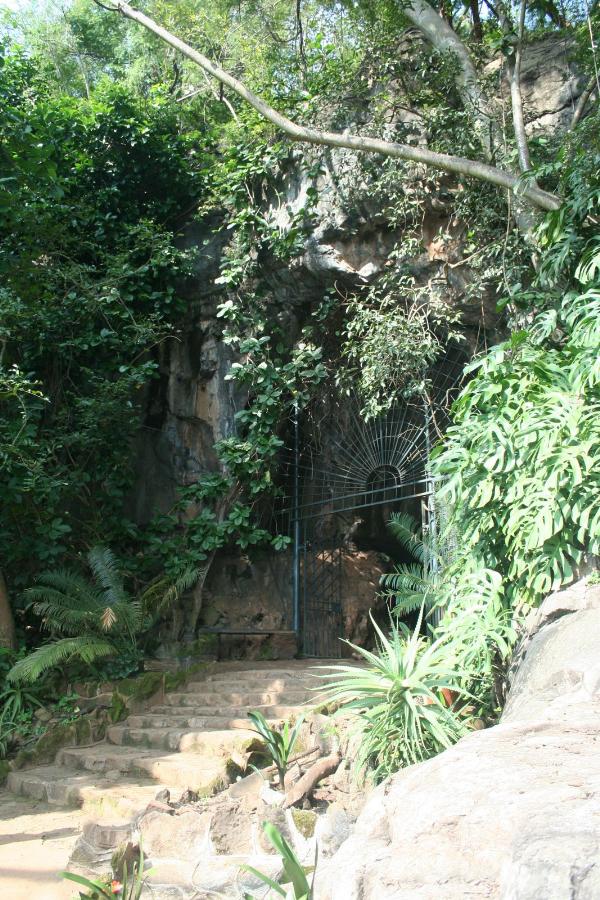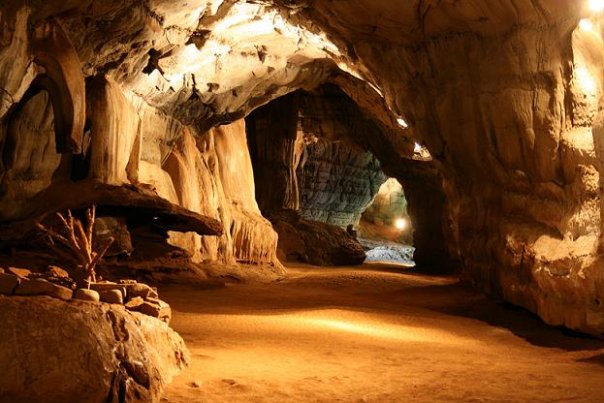Sudwala Caves EarthCache
-
Difficulty:
-

-
Terrain:
-

Size:  (not chosen)
(not chosen)
Please note Use of geocaching.com services is subject to the terms and conditions
in our disclaimer.
The Sudwala caves were formed when gigantic stresses cracked the
dolomite.

Rainwater percolated into the cracks, carrying carbon-dioxide and
dissolving away the limestone in the rock, forming in the process a
subterranean dreamland of vast caverns and passageways decorated
with stalactites and stalagmites in all manner of weird fanciful
shapes.
These incredible caverns lie in the Drakensberg escarpment
separating the Highveld from the lowlands of Mpumalanga.The Sudwala
Caves are situated in Pre-cumbrian dolomites of the Malmani Group,
formed over 3000 million years ago. The dolomite is a carbonate
sedimentary rock consisting mainly of the mineral dolomite CCa
Mg(CO3)2. The dolomite is a marine deposit formed from Chemical
precipitation when the Lowveld area was covered by warm Shallow
seas in the Pre-cumbrian time.

The caves were used as shelter by Pre-historic man in the form of
"Homo-Habilis" / "Handyman." approximately 1.8 million years ago.
Habilis has smaller cheek teeth, larger front teeth, a relatively
large brain and skeleton more like that of modern humans. They
mainly used the cave entrance as shelter during bad weather.
Excavations are still in progress and have thus far yielded a fine
collection of stone-age tools which are on display at the cave
entrance.
The Sudwala cavern complex is dominated by the PR Owen Anphitheater
chamber with its lofty corridor measuring 150 metres connected to
its centre. The chamber itself is roughly circular, 70 metres in
diameter and reaches a height of 37 metres to the peak of a
dome-like feature in its roof. A stream of fresh, cool air from an
unknown source permeates the spacious corridors, maintaining these
at an even temperature of 17°C all year round.
Two factors strongly preclude the possibility of finding true cave
animals in the main cave:
a) The cave is extremely dry although it must have been wet when
the formations were being developed.b) The illumination and traffic
necessarily present due to the tourist travel drive cave forms into
more remote, and to man, inaccessible areas of the cave.
The only organisms that can be seen in the cave along the tourist
route are the insectivorous bat the Horseshoe species (Rhinolophus
Londeri and Rhinolophus Hildibrandi).
The algae and ferns in the P.R.Owen Hall and along the tourist
trail are not to be considered as part of the biology of the cave.
They exist only because of the lights in the cave. From the
viewpoint of the professional speleologist their presence is most
undesirable since the green stain contaminates the true colour of
the formations. Unfortunately it is practically impossible to
prevent the introduction of spores and seeds into the touristcaves.
Centipedes and rodents can be seen occasionally in the entrance
zone.

THE SUDWALA DOLOMITE - HOW ROCK AND CAVE FORMED
The principle pod of nature is water. The first deposit of this
sedimentary rock, was laid down approximately 3800 million years
ago. This deposit known as the Malmani Dolomite Ridge, consists of
successive layers of erid, shale, conglomerate, chert and dolomite
CCaMg (CO3) . This was all laid down beneath water when Africa was
still part of Gonolwanaland and eventually left to solidify.
A major climatic change or uplift to the earth's surface swept away
the sea under which they had been deposited. Over vast periods of
time the water returned and other sedimentary deposits were left in
the area. The limestone in this dolomite represents a period when
sea water was concentrated to such an extent that chemical
precipitation of lime-rich material was possible . For a long time
after it had been deposited, the dolomite was affected only by
tectonic/earth movement which folded and faulted.
A considerable change began about 300 million years ago. The
structural deformation brought the Sudwala Dolomite into the
eathering zone. As the water table fluctuated with changes in the
topography or climate, acidic ground matter found its way into the
cracks in the dolomite and slowly but persistently dissolved the
surrounding rock. A series of underground chambers eventually
formed in the dolomite, the rock being carried away in solution by
the water as it seeped out, or occasionally found an escape route
and flowed away, leaving the chamber to fill again when the escape
route became blocked by a rock fall or some obstruction. The
chambers which evolved were not originally connected. Rather they
resembled a sequence of underground chambers/reservoirs constantly
enlarging their capacity as water seeped away and was replaced by
water capable of dissolving and holding in solution more
limestone.
Then again an upheaval occurred, the water table dropped and change
again took place. The underground reservoirs found their water
steadily seeping away leaving nothing substantial to immediately
replace it. The caves are estimated to be about 240 million years
old and are the oldest known caves in the world.
HOW THE CALCIUM FORMATIONS ARE FORMED
As rain water seeps through plant matter, it absorbs a quantity of
CO2 resulting in the formation of Carbonic acid. The carbonic acid
seeps through the dolomite and picks up calcium carbonate in a
solid form. It now forms an easy soluble calcium bicarbonate. It
trickles down from the ceiling of the cave. Dripping from the
ceiling, the water encounters an atmosphere far less rich in CO2
than the overlying sediments. Natures pre-disposition to maintain a
balance induces a CO2 transfer from the water into the air.
The acidity of the water drops and bicarbonate emerges from the
solution as solid calcium carbonate particles which are then shed
by the water. As each drop of water emerges from the ceiling its
calcium content is shed and forms a ring around the circumference
of the drop. The nucleus of pure water then falls, leaving behind
the calcite ring. The sequence is repeated and the rings build up
creating a hollow tube. As the formation develops, the centre tends
to fill and the deposition continues on the outside, eventually
forming a stalactite. If the dripping is too rapid for deposition,
or the water contains more calcium-carbonate than can immediately
be shed, It carries the surplus down to the floor of the chamber,
forming a stalagmite, often with a saucer-shaped hollow known as a
splash cup, at the tip. Curtains and walls of stalactites and
stalagmites can develop if the water drips along the length of a
crack in the ceiling.
The growth rate for a stalactite at the Sudwala Caves is
approximately 2,5cm in a hundred years. As regards calcium
structures there are several main ones to keep an eye out for, such
as
1) "The lowveld rocket, " a stalactite stalagmite column,
approximately 150 million years old;
2) "The screaming monster", approximately 160 million years
old;
3)"Samsons pillar, approximately 200 million years old.
The age of these formations are geologically determined by the
"Rhebedium Stronptium" test, which measures the radio active decay
of formations.
FOSSILS
In the Pre-cambrian, all the early animals were soft bodied and
thus did not fossilize well at all. However there are primitive
plant fossils called "collenia" to be viewed in the Sudwala caves.
They were a type of blue-green algae that used to float on the
ocean. They were tubular shaped and approximately 2 m in length. It
was one of the first oxygen producing plants that produced oxygen
safe enough for us to breath. It dates back 2000 million years when
these plants were formed. It got compacted in the rock, because at
high tide sand and silt would get washed over it and get caught up
in it, another layer would grow and the same process would
occur.
To claim a find on this cache you need to try and find each of
the following and photograph each with one of the members of your
team (or have your GPSr visable in the photo):
1)The lowveld rocket
2)The screaming monster, &
3)Samsons pillar
as well as find out and mail me the answer to the following
question:
What is the approximate estimated length of the cave
network?
I know it is not always nice to have to
pay a fee to do a cache, but you can be sure that this one is well
worth paying for:-
COST OF TOUR
To minimize damage to the caves one may only enter with a
tour-guide. There is never a more than 15 minute wait before the
next guide. (Besides the obvious fact that you may get lost and
never come out again!)
The current rates are:
Adults: R 60-00 p/p 16yrs
older Pensioners: R 40-00 p/p 60yrs & older
Children: R 25-00 p/p 05yrs to 15 yrs
Under 5 yrs – Free
Additional Hints
(No hints available.)